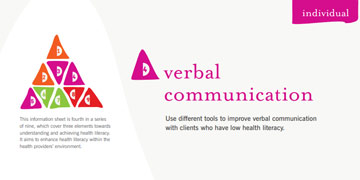How Can We Help?
Why is verbal communication important?
Most communication in a health service happens when the worker and client come together and talk. Health professionals and organisations can experience challenges in achieving effective verbal communication with clients from a culturally and linguistically diverse background. There is often a gap between what health professionals intend to convey and what the client understands. Building interpersonal and cross-cultural communication capabilities amongst health professionals is essential in facilitating health literacy(1). There are a number of strategies that health professionals can use to communicate more effectively.
Understanding the client
The first step in effective verbal communication is to understand the client’s perspective. In this step, service providers must put aside the assumptions they bring to their interactions, and try to see the problem through the clients’ eyes. It is important to let the client explain the health issue from their perspective before moving forward. This approach also allows the client to take ownership of their health problem, expressing it in their own words. One tool you can use when speaking to a client is ‘Kleinman’s Explanatory Model of Health.’ This provides suggested questions health professionals can ask to explore the clients’ understanding.
Clearly explain your perspective
After exploring the client’s view point, the health professional should clearly explain their own perspective to the client. To do this, it is important to have an understanding of the beliefs clients have about health and how their bodies work. No single health belief is the ‘correct’ one, instead it is important to respect the client’s beliefs.
Checking the client’s understanding
In all verbal communication it is integral to make sure the client has understood. It is impossible to know how health literate a person is through one interaction, and even individual health literacy tests aren’t conclusive. So different approaches can be used:
- The ‘Universal Precautions Approach’ assumes that all patients have a low level of health literacy, when checking for understanding
- The teach-back technique is an effective method for ensuring that clients understand what you have told them. See the Using the teach-back technique information sheet.
Two important points to note when checking for client understanding is:
- make sure you are careful not make the patient feel ‘tested’ as this can increase stigma
- break information into small pieces, so it can be easily understood
Building client rapport and dialogue
The most important part of verbal communication with a client is to build rapport and encourage the patient to speak freely, and feel empowered. This helps clients make health decisions for themselves. This can be encouraged through strategies such as:
- Ask Me 3 – this is often used when new clients join a service. It encourages the client to ask three specific important questions to the health professional
- Motivational Interviewing – this encourages the service provider to express empathy and support the client’s self-efficacy by avoiding argumentation and respecting their beliefs.
It is important to understand that all verbal communication strategies have their limitations – make sure the ones you choose to use are suited to your client and context. Reference: 1. Department of Health, Victorian Government, Health Literacy Background paper, 2013
English Resource:
Last reviewed: Dec 2015
Resource Type: Tip/Fact Sheets

